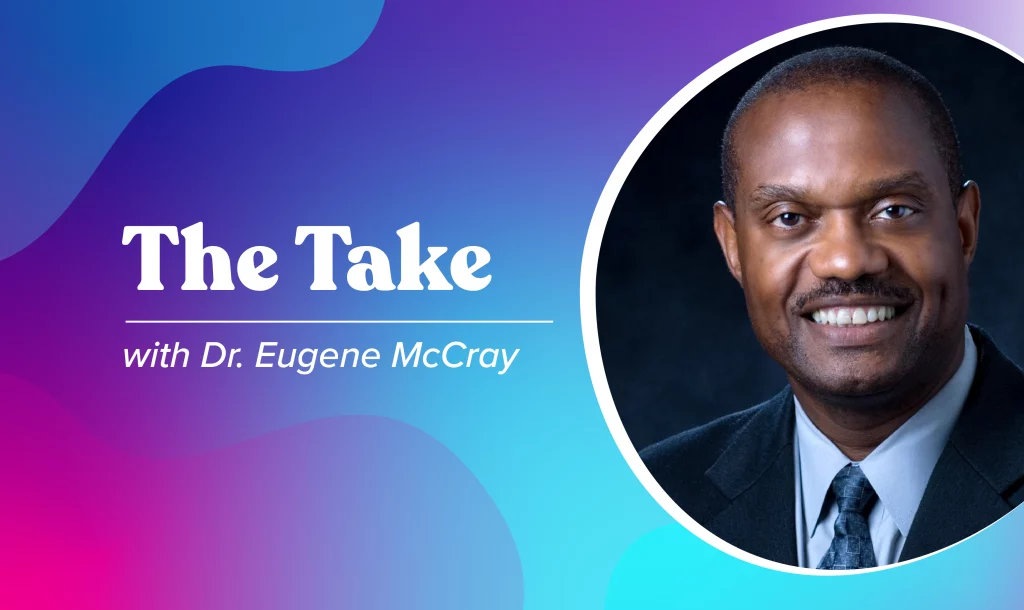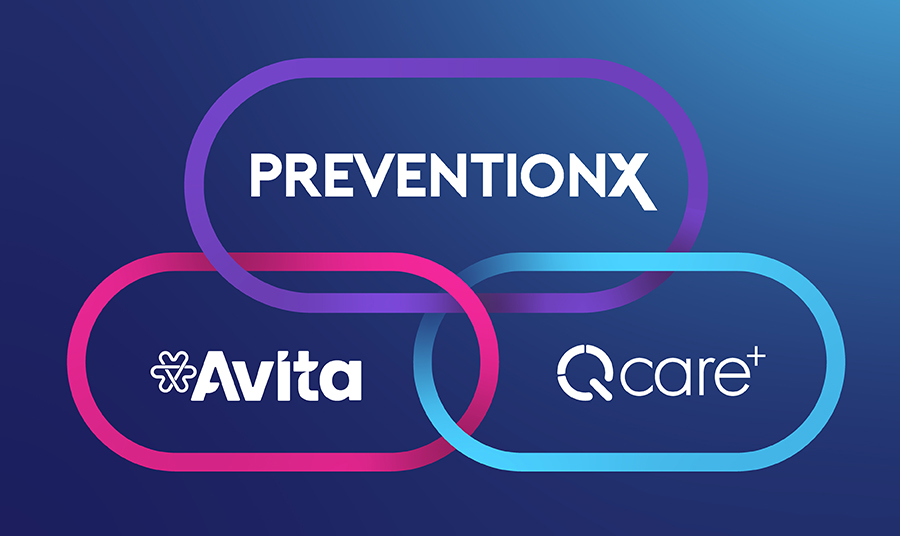As an almost 40-year veteran of the Centers for Disease Control (CDC), Dr. Eugene McCray served on the front lines of the HIV/AIDS epidemic from its inception. In this issue of “The Take,” Avita’s Chief Advocacy Officer Glen Pietrandoni gets the inside track on what it was like to lead both the CDC’s Global AIDS Program and its Division of HIV/AIDS Prevention, why uniting communities around the importance of PrEP is critically important, and how the internationally known advocate continues to fight for health equity well into his retirement.
Glen: Eugene, you started your career at the CDC as an officer in the U.S. Public Health Service in the Epidemic Intelligence Service in 1983, just as the HIV/AIDS crisis was in its infancy. Can you give us a glimpse into what the mood there was like at the time?
Dr. McCray: When I arrived, there was this sense of urgency and the feeling that we were racing against time because there were so many unanswered questions. I don’t recall any confusion or panic at the CDC back then. But there was a healthy amount of fear, along with what I would call measured excitement about the opportunity to discover a new disease and find the cure. That’s how we were thinking then. Little did we know.
There was so little understood about the disease, so we had a lot of questions: Where did it come from? Was it a virus or something else? Why was it primarily affecting men who have sex with men and people who injected drugs? Who else was at risk? What could be done to prevent others from getting infected, and how could we treat people effectively so they didn’t die?
There was an urgency to find answers and implement measures to stop the spread of the disease and treat those who were already ill. And as an epidemic intelligence service officer, I was thrown in the middle of that. My job was to go out into the field, interview people, observe what was going on, and try to understand what was happening.
My particular role in those early years was to determine if health care workers were at increased risk of getting HIV/AIDS while caring for these patients. I spent much time working in health care settings and prisons, trying to educate people and help them be less afraid.
We didn’t just talk about HIV/AIDS. We discussed other community concerns that would need to be addressed first if we were going to get the community to support the disease prevention work we wanted to do.
– Dr. Eugene Mccray
Leading the Global AIDS Program: “People expected us to fail.”
Glen: Fast forward 17 years, when you became the director of the Global AIDS Program. By 2004, you had led the establishment of CDC HIV programs in 25 countries across Africa, Asia, and the Caribbean/Latin America. What were the top three lessons you learned regarding how to mobilize scientists, politicians, advocates, and activists around the common cause of ending HIV and AIDS?
Dr. McCray: That was an interesting time. Stateside, people were not confident that we could make a difference [from a global perspective]. We would be dealing with impoverished countries with little health infrastructure and physicians and nurses with no idea how to identify and care for people with HIV. So, the little bit of money we got to start this program was not given with a lot of support.
People expected us to fail—that was the environment I was working in at the time. When it came to these developing countries, people thought, “How can you talk about preventing HIV when people don’t have clean drinking water, food to eat all the time, or good places to live?” And there was a lot of denial in many of these countries about whether HIV was a problem.
The three most important lessons I learned—and that I think are still relevant today—are:
- Develop political will and buy-in at all levels:
We spent a fair amount of time working directly with governments’ ministries of health and ministries of finance to get them on board, which was not easy.More rewarding for me was the work we did with local communities, starting with the districts, counties, and villages. We didn’t just talk about HIV/AIDS, or “Slim Disease,” as it was called at that time in Africa. We discussed other community concerns that would need to be addressed first if we were going to get the community to support the disease prevention work we wanted to do.
We also strived to get buy-in from the local teaching and academic institutions. We needed them to help us measure the impact of our work so we could learn from the process.
- Create the strategic partnerships needed to do the work:
While the CDC was getting money from the federal government [for the Global AIDS Program], money that comes from the federal government also comes with all kinds of restrictions. We couldn’t use our funds to build clinics or purchase drugs at the time. So, it was necessary to develop partnerships that would complement many of our initiatives.Public, private, academic, and foundation partnerships were all critical to getting things done. For example, the Department of Defense could build buildings. So, they would come in and build a clinic for us, and then we’d use that clinic to provide patient care and services.
- Engage and support the community:
I want to emphasize the importance of getting the entire community involved in all aspects of our program, including the planning, implementation, and feedback loop.I’ll highlight one important example: The African Comprehensive HIV/AIDS Partnerships (ACHAP). It was primarily a partnership between The Bill and Melinda Gates Foundation, Merck & Co., Inc., and of course, the government of Botswana. The CDC was not a core funding partner, but we offered technical assistance and support.
Botswana was one of the countries in Africa that had the highest burden of AIDS. There were equal numbers of women and men infected, and they had a very high rate of mother-to-child transmission. But over the first five years of that program, there was a significant reduction in the number of people progressing from HIV to AIDS and in mother-to-child transmission.
We also partnered with Uganda to serve a rural community there. We had health care advocates from the community heading out on motorcycles and bicycles to serve patients, so people only had to come into the clinics once every three months. Unfortunately, many of these volunteers were unpaid. They did a lot of work, and everybody expected them to do it for free. Ensuring we train, support, and pay community volunteers is critical. We weren’t allowed to do so at the time, but today I would certainly fight for community volunteers to be paid.
People expected us to fail–that was the environment I was working in at the time. When it came to these developing countries, people thought, ‘How can you talk about preventing HIIV when people don’t have clean drinking water, food to eat all the time, or good places to live?’
– Dr. Eugene Mccray
The importance of CHCs in the domestic fight against HIV
Glen: On the domestic front, in 2014, you were named director of the Division of HIV/AIDS Prevention at the CDC, where you guided the organization’s domestic HIV prevention response and its work through health departments and community organizations. A question for you: Considering how critical community health centers (CHCs) are to bridging the gap between the U.S. government’s HIV/AIDS prevention initiatives and underserved communities, why are they still having such trouble securing the funding they need?
Dr. McCray: When I first came on board [the CDC’s Division of HIV/AIDS Prevention], that was one of the first questions I asked. Why are we not working directly with community health centers and engaging them in providing HIV prevention services?
Then we met with the Health Resources and Services Administration (HRSA) and folks in Washington and found there was little to no political will to provide financial support to CHCs to do this work. The ones that were already doing the work were getting support elsewhere. Frankly, I was told that the directors of many of these CHCs were just not interested [in offering HIV prevention services]. That was problematic to me because these centers are often in underserved communities, and many of the people at risk of or living with HIV went to these centers for primary care, but their HIV was being completely ignored.
So, I agree with you completely that community health centers play a very important role in HIV prevention, and I’m very happy that many of them have stepped up to do this work, especially as part of The Ending the HIV Epidemic in the U.S. initiative (EHE). But I’m completely dismayed and disappointed that our federal government continues to provide inadequate funding for them to provide PrEP and other HIV prevention services. It will not get done if they don’t get additional funding.
Why is that happening? I have my speculations. I think it’s two things: There isn’t the political will in congress to do it, and the community health center community must work together to provide the mass support needed to mobilize congress, state, and local governments to act.
Somehow, we’ve got to figure this out. There has to be a way to get the leadership of these centers to work together, to really make PrEP a priority. The EHE initiative could and should play a major role. Beyond the provision of funds, [EHE leadership] should be thinking about a structure to provide education and support to the directors of these centers, as well as to congress, state, and local legislators, so they understand the important role CHCs can play.
Community health centers play a very important role in HIV prevention, and I’m very happy that many of them have stepped up to do this work. But I’m completely dismayed and disappointed that our federal government continues to provide inadequate funding for them to provide PrEP and other HIV prevention services.
– Dr. Eugene Mccray
Why pharmacies & community organizations should lead PrEP education
Glen: You’ve dedicated your career to pursuing health equity for some of the nation’s most disadvantaged populations. More than 40 years since the start of the AIDS epidemic, HIV prevention and treatment still carries a stigma, specifically within certain racial minority communities.
Let’s bring it back to some eye-opening PrEP stats: PrEP use has grown rapidly among white Americans since it was introduced in 2012. White people represented 65% of PrEP users in 2021, but just 26% of new HIV diagnoses in 2020. But Black and Latinx Americans have not seen the same favorable outcomes. Black people made up 14% of PrEP users in 2021 but accounted for 42% of new HIV diagnoses in 2020. Latinx people made up 17% of PrEP users but accounted for 27% of new diagnoses.
What’s the key to turning the tide here? Increasing access? Awareness? Education?
Dr. McCray: One of the things I’ve always advocated for is that PrEP should be available at no cost to anybody who wants it. There’s a significant cost associated with managing a person on PrEP that really needs to be mitigated. Ideally, I think those costs should be forgiven for uninsured people as part of the EHE.
But that’s only addressing a small part of the equity problem. Health equity issues are rooted in access, stigma, and other [social determinants of health]. Even with free PrEP and mitigation of some of the costs of social clinical care, there’s still hesitancy among health care providers in Black and Latinx communities to take on PrEP. So, a lot of education needs to happen, both for patients within the Black and Latinx communities, as well as for health care providers caring for those populations.
Glen: How do we make that education happen?
Dr. McCray: I don’t have all the answers. I do know that PrEP is not even talked about in most medical training programs. But there are other options to consider for expanding knowledge around it.
One is leveraging pharmacies. Every person in the community goes to a pharmacy to get medication. They are a great place to learn about health care concerns, including prevention, vaccines, and drug information. So, pharmacies in every community should be involved in PrEP in some way. If we could make that happen, it could go a long way toward dealing with some of the stigma. Because when people come into a pharmacy, nobody knows what they’re there for.
We talked about getting community health centers more engaged, but I also think we could take better advantage of small community-based organizations that don’t provide medical services. They could be important resources for educating local populations about PrEP and its potential for preventing HIV infections.
Of course, the real solution here is an effective [HIV prevention] vaccine. I’m encouraged by the research into RNA technology used to develop the COVID-19 vaccine and optimistic that that technology could be used to develop an effective HIV vaccine. Some of my colleagues at the National Institutes of Health believe this is a real possibility in the next couple of years.
Pharmacies are great places to learn about health care concerns, including prevention, vaccines, and drug information. In every community [they] should be involved in PrEP in some way.
– Dr. Eugene Mccray
Looking at advocacy through the lens of social justice & equity
Glen: That would be incredibly exciting. So, what’s next for you, Eugene? I have the inside track on one initiative: You’re stepping up as Board Chair of AIDS United in October just as I’m stepping down. What are your goals for leveraging that platform, and what else do you have up your sleeve?
Dr. McCray: I’ve spent the last 36 years working at the CDC and had a wonderful career that I wouldn’t exchange for anything. But now, I’m ready to spend my time giving back to the community that’s been so supportive of me over the years. Being an openly gay person at the CDC and in other environments was not easy. But I had community members who made sure I was cared for. So, I want to give back, and that’s why I agreed to join the board of AIDS United and sit on the board of a California organization called TruEvolution.
It’s an honor for me to move into the AIDS United role, and your shoes will be hard to fill. My main goal is to provide strong leadership and ensure that the organization is well-positioned to continue—and even expand—its role as a national leader in HIV policy and advocacy, technical assistance, and grant making. The work of AIDS United must always be done from the lens of ensuring social justice and equity because that’s an important issue, and it will become an even more important issue depending on the outcome of the November elections. Effective fundraising is going to be key.
I also want to travel a little bit and re-engage with the family and friends I’ve neglected a bit during the past 15 to 20 years due to my crazy work schedule. Global and domestic HIV initiatives are all-consuming, as you might imagine.
Glen: As you walk through your professional history, it’s clear what an impact you’ve made around the globe. Being able to speak with you about it gave me chills. Thank you for joining me today.
The work of AIDS United must always be done from the lens of ensuring social justice and equity because that’s an important issue, and it will become an even more important issue depending on the outcome of the November elections.
– Dr. Eugene Mccray
What’s your take? Whether you have an idea for a future guest or topic for our blog post series or would like to comment on the insights of one of our past guests, we’d love to hear from you! Reach out to us on social media on our LinkedIn, Twitter, and Facebook channels.
About Eugene McCray:
Dr. Eugene McCray recently retired from the Centers for Diseases Control and Prevention, where he served as the Director of the CDC’s Division of HIV/AIDS Prevention (DHAP). In this role, he was responsible for U.S. domestic HIV prevention activities, budget, and policy. More specifically, Dr. McCray oversaw program, research, surveillance, and communications activities designed to significantly reduce HIV infections in the United States and improve health equity. Before joining DHAP in 2014, he served as a Medical Epidemiologist and Chief of the International Research and Programs Branch in the Division of Tuberculosis (TB) Elimination. He was the first Director of CDC’s Global AIDS Program from 2000 to 2004. Dr. McCray has won numerous awards for his scientific and public health contributions—including the U.S. Public Health Service (PHS) highest honor award, the PHS Distinguished Service Medal, and the CDC highest honor award, the William C. Watson Medal of Excellence. He is currently a member of the Board of Directors for AIDS United, a national non-profit organization in Washington, D.C., and TruEvolution, a local non-profit organization in Riverside, California.
About Glen Pietrandoni:
Glen Pietrandoni is chief advocacy officer at Avita, an award-winning pharmacy leader, passionate 340B program advocate, and internationally respected HIV and LGBTQ+ activist. He’s deeply engaged in Avita’s mission to advocate for health equity and the 340B Drug Pricing program and works to bring together stakeholders from the pharmaceutical industry and patient advocacy arenas. Through webinars, conferences, Avita’s thought leadership blog series “The Take,” and the organization’s engagement with multiple community and trade associations, Glen leads Avita’s educational and awareness efforts and acts as a voice for its covered entity partners and patients. He continually fights for continued access to the 340B program and advances stigma-free HIV, PrEP, LGBTQ+, and sexual wellness care for underserved patient populations. Glen serves on the Board of Pharmacy for the State of Illinois, was formerly chairman of the Board of Trustees of AIDS United, and sits on the board of Community Voices for 340B (CV340B) and the ADAP Advocacy Association. He has earned American Academy of HIV Medicine and Apexus 340B certifications.




